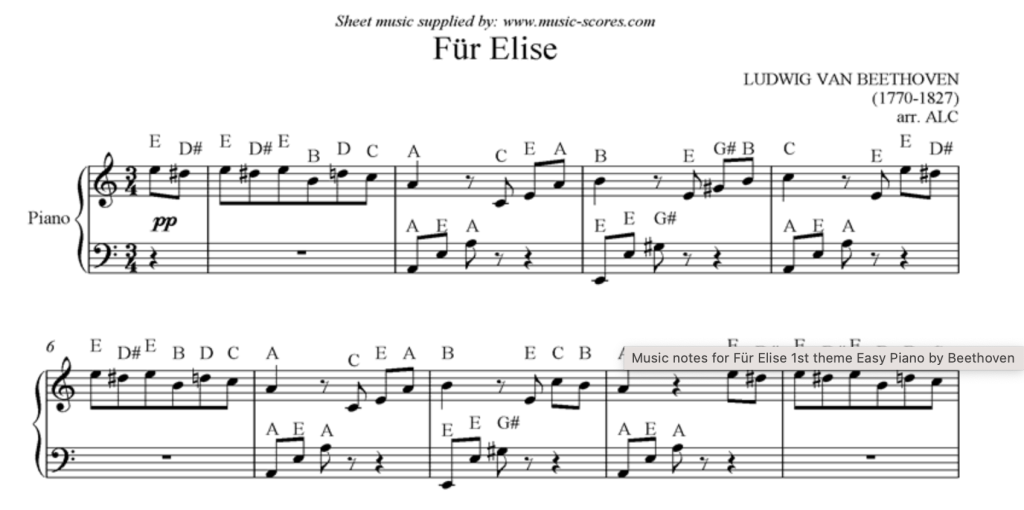Easy Für Elise for Beginner Piano
In this article we hope to give you some hints and tips on how to play Für Elise. You will most probably recognise this piece of music by Beethoven as soon as you hear it. The first nine notes are the giveaway!
Although this piece is commonly known as Für Elise, officially it’s Bagatelle No. 25 in A minor.
We have several versions of the sheet music on our website, all for different instruments. These include Alto Sax, Cello, Clarinet and Oboe. However, in this post we’re focussing on the piano or keyboard.

The piano sheet music on our site for this piece is aimed for beginners. As you can see it includes the note names to help. At just 30 bars or two pages long this easy piano version is simply the first theme to help give you confidence.
You won’t need to be a member to download the sheet music. This is one of our free pieces.
How to play Für Elise Video Tutorial
There are many videos on YouTube that show you how to play Für Elise. This is one of our favourites.
More Easy Sheet Music
We have music for all levels of expertise and types of instrument on music-scores.com. Take a look at our Beginner Sheet Music section to find more.
The musical structure of Für Elise
Für Elise is a popular piano composition by Ludwig van Beethoven. It was written around 1810 and published posthumously in 1867, many years after his death.
The piece is written in the key of A minor and is in a simple binary form (ABA), with each section being repeated.
The first section is characterised by a simple yet memorable melody that is played over a repeated arpeggio pattern (the notes of a chord played in rapid sucession, either ascending or descending) in the left hand. This section is in A minor and is played softly, with a slow tempo.
The second section is in the contrasting key of C major and is played louder and faster. It features a more complex melody and a broken chord pattern in the left hand. This section builds in intensity until it reaches a climactic point, after which it returns to the first section.
The piece concludes with a coda (the concluding passage of a piece or movement, typically forming an addition to the basic structure) that features a modified version of the first section.
The popularity of Für Elise can be attributed to its simple yet memorable melody, which has become one of the most recognisable tunes in classical music. Its popularity has also been aided by its accessibility, as it is a relatively easy piece to learn and play for beginning and intermediate pianists.
Despite its popularity, the origin and meaning of the title Für Elise remain a mystery. It is speculated that the piece was originally intended as a dedication to one of Beethoven’s female acquaintances, but the true identity of Elise has never been definitively established.
Further Reading
You can read the story behind this popular piece of classical music on our blog post – Who was Elise?
Read more about the composer himself on our short biography page about Ludwig von Beethoven. The British Library also has a comprehensive item about Beethoven.
Pingback: Beethoven Sheet Music